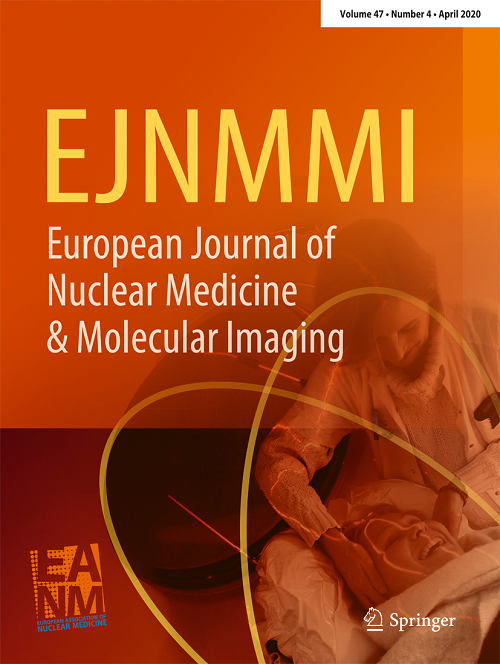Deep learning-based non-invasive prediction of PD-L1 status and immunotherapy survival stratification in esophageal cancer using [18F]FDG PET/CT.
IF 7.6
1区 医学
Q1 RADIOLOGY, NUCLEAR MEDICINE & MEDICAL IMAGING
European Journal of Nuclear Medicine and Molecular Imaging
Pub Date : 2025-08-14
DOI:10.1007/s00259-025-07463-0
引用次数: 0
Abstract
PURPOSE This study aimed to develop and validate deep learning models using [18F]FDG PET/CT to predict PD-L1 status in esophageal cancer (EC) patients. Additionally, we assessed the potential of derived deep learning model scores (DLS) for survival stratification in immunotherapy. METHODS In this retrospective study, we included 331 EC patients from two centers, dividing them into training, internal validation, and external validation cohorts. Fifty patients who received immunotherapy were followed up. We developed four 3D ResNet10-based models-PET + CT + clinical factors (CPC), PET + CT (PC), PET (P), and CT (C)-using pre-treatment [18F]FDG PET/CT scans. For comparison, we also constructed a logistic model incorporating clinical factors (clinical model). The DLS were evaluated as radiological markers for survival stratification, and nomograms for predicting survival were constructed. RESULTS The models demonstrated accurate prediction of PD-L1 status. The areas under the curve (AUCs) for predicting PD-L1 status were as follows: CPC (0.927), PC (0.904), P (0.886), C (0.934), and the clinical model (0.603) in the training cohort; CPC (0.882), PC (0.848), P (0.770), C (0.745), and the clinical model (0.524) in the internal validation cohort; and CPC (0.843), PC (0.806), P (0.759), C (0.667), and the clinical model (0.671) in the external validation cohort. The CPC and PC models exhibited superior predictive performance. Survival analysis revealed that the DLS from most models effectively stratified overall survival and progression-free survival at appropriate cut-off points (P < 0.05), outperforming stratification based on PD-L1 status (combined positive score ≥ 10). Furthermore, incorporating model scores with clinical factors in nomograms enhanced the predictive probability of survival after immunotherapy. CONCLUSION Deep learning models based on [18F]FDG PET/CT can accurately predict PD-L1 status in esophageal cancer patients. The derived DLS can effectively stratify survival outcomes following immunotherapy, particularly when combined with clinical factors.基于深度学习的食管癌患者PD-L1状态无创预测及FDG PET/CT免疫治疗生存分层[18F]。
目的:本研究旨在开发并验证使用[18F]FDG PET/CT预测食管癌(EC)患者PD-L1状态的深度学习模型。此外,我们评估了衍生的深度学习模型评分(DLS)在免疫治疗中生存分层的潜力。方法在这项回顾性研究中,我们纳入了来自两个中心的331例EC患者,将他们分为训练组、内部验证组和外部验证组。对50例接受免疫治疗的患者进行随访。我们利用预处理[18F]FDG PET/CT扫描建立了四种基于resnet10的3D模型——PET + CT +临床因素(CPC)、PET + CT (PC)、PET (P)和CT (C)。为了比较,我们还构建了一个包含临床因素的logistic模型(临床模型)。将DLS作为生存分层的放射标志物进行评估,并构建预测生存的nomogram。结果该模型能准确预测PD-L1状态。预测PD-L1状态的曲线下面积(aus)分别为:训练组CPC(0.927)、PC(0.904)、P(0.886)、C(0.934)、临床模型(0.603);内部验证队列的CPC(0.882)、PC(0.848)、P(0.770)、C(0.745)和临床模型(0.524);外部验证队列CPC(0.843)、PC(0.806)、P(0.759)、C(0.667)、临床模型(0.671)。CPC和PC模型表现出较好的预测性能。生存分析显示,大多数模型的DLS在适当的截断点上有效地对总生存期和无进展生存期进行分层(P < 0.05),优于基于PD-L1状态的分层(合并阳性评分≥10)。此外,将模型评分与临床因素结合到x线图中,可以提高免疫治疗后存活的预测概率。结论基于[18F]FDG PET/CT的深度学习模型能够准确预测食管癌患者PD-L1状态。衍生的DLS可以有效地对免疫治疗后的生存结果进行分层,特别是当与临床因素结合时。
本文章由计算机程序翻译,如有差异,请以英文原文为准。
求助全文
约1分钟内获得全文
求助全文
来源期刊
CiteScore
15.60
自引率
9.90%
发文量
392
审稿时长
3 months
期刊介绍:
The European Journal of Nuclear Medicine and Molecular Imaging serves as a platform for the exchange of clinical and scientific information within nuclear medicine and related professions. It welcomes international submissions from professionals involved in the functional, metabolic, and molecular investigation of diseases. The journal's coverage spans physics, dosimetry, radiation biology, radiochemistry, and pharmacy, providing high-quality peer review by experts in the field. Known for highly cited and downloaded articles, it ensures global visibility for research work and is part of the EJNMMI journal family.

 求助内容:
求助内容: 应助结果提醒方式:
应助结果提醒方式:


